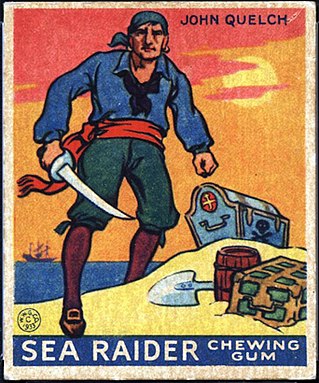Related Research Articles

Edward Teach, better known as Blackbeard, was an English pirate who operated around the West Indies and the eastern coast of Britain's North American colonies. Little is known about his early life, but he may have been a sailor on privateer ships during Queen Anne's War before he settled on the Bahamian island of New Providence, a base for Captain Benjamin Hornigold, whose crew Teach joined around 1716. Hornigold placed him in command of a sloop that he had captured, and the two engaged in numerous acts of piracy. Their numbers were boosted by the addition to their fleet of two more ships, one of which was commanded by Stede Bonnet; but Hornigold retired from piracy toward the end of 1717, taking two vessels with him.

William Kidd, also known as Captain William Kidd or simply Captain Kidd, was a Scottish privateer. Conflicting accounts exist regarding his early life, but he was likely born in Dundee and later settled in New York City. By 1690, Kidd had become a highly successful privateer, commissioned to protect English interests in America and the West Indies.
Robert Culliford was a pirate from Cornwall who is best remembered for repeatedly checking the designs of Captain William Kidd.

The Piracy Act 1698 was an Act of the Parliament of England passed in the eleventh year of King William III. The main purpose behind the statute was to make some corrections to the Offences at Sea Act 1536.

James Gilliam, or James Kelly was an English pirate and buccaneer active off the coasts of Spanish South and Central America and later in the Indian Ocean. He sailed under several different pirate captains but is best remembered for his brief association with William Kidd.

John Quelch was an English pirate who had a lucrative but very brief career of about one year. His chief claim to historical significance is that he was the first person to be tried for piracy outside England under Admiralty Law and thus without a jury. These Admiralty courts had been instituted to tackle the rise of piracy in colonial ports where civil and criminal courts had proved ineffective.
Charles Harris (1698-1723) was an English pirate active in the 1720s. He is best known for his association with George Lowther and Edward Low.
Saladin was a British barque that made voyages between Britain and the coast of Peru, carrying shipments of guano. The ship is best known for its demise in an act of mutiny, murder and piracy which began with the murder of its captain and officers and ended with the ship being stranded off the coast of Nova Scotia on 21 May 1844, followed by the last major piracy trial in Canada.
Brigstock Weaver was an English pirate active in the Caribbean. He is best known for his association with fellow pirates Thomas Anstis and Bartholomew Roberts.
William Burke was an Irish pirate and trader active in the Caribbean and near Newfoundland, best known for aiding William Kidd.
William Read was a pirate active in the Indian Ocean near Madagascar. He is best known for rescuing fellow pirate captains John Bowen and Thomas White.

Philip Roche (1693–1723) was an Irish pirate active in the seas of northern Europe, best known for murdering the crews and captains of ships he and his men took over.
Richard Noland was an Irish pirate active in the Caribbean. He was best known for sailing with Samuel Bellamy before working for the Spanish.
John Prie was a minor pirate in the Caribbean.
Lewis Ferdinando was a pirate active near Bermuda during the Golden Age of Piracy.
Francis Demont was a pirate active in the Caribbean. His trial was important in establishing Admiralty law in South Carolina.
Richard Tookerman was born on 16 May 1691 in Devon, Cornwall, England. He was the son of Josias Tookerman, a clergyman, and younger brother of Josias Tookerman II, a clergyman sent by the Society for the Propagation of the Gospel (SPG) to Jamaica. He married Katherine Grant, widow of John Grant of Charleston, South Carolina by 1717. As a pirate, smuggler, and trader active in the Caribbean and the Carolinas, he became best known for involvement with pirates Stede Bonnet and Bartholomew Roberts.
Don Benito was a Spanish pirate and guarda costa privateer active in the Caribbean.
William Coward was a minor pirate active off the coast of Massachusetts. He is known for a single incident involving the seizure of one small vessel, largely thanks to events surrounding his trial.
David Williams was a Welsh sailor who turned pirate after being abandoned on Madagascar. He was only briefly a captain, and is best known for sailing under a number of more prominent pirate captains.
References
- 1 2 3 Gosse, Philip (1924). The Pirates' Who's Who by Philip Gosse. New York: Burt Franklin. Retrieved 23 June 2017.
- 1 2 3 Bowling, Tom (2013). A Brief History of Pirates and Buccaneers. London: Little, Brown Book Group. ISBN 9781472107701 . Retrieved 2 August 2017.
- 1 2 3 Crook, G. t (1926). The Complete Newgate Calendar Vol I (Ex-Classics (expanded from the Navarre original) ed.). London: The Navarre Society Limited. Retrieved 2 August 2017.
- ↑ Durston, Gregory (2017). The Admiralty Sessions, 1536-1834: Maritime Crime and the Silver Oar. Newcastle upon Tyne: Cambridge Scholars Publishing. p. 81. ISBN 9781443873611 . Retrieved 2 August 2017.
